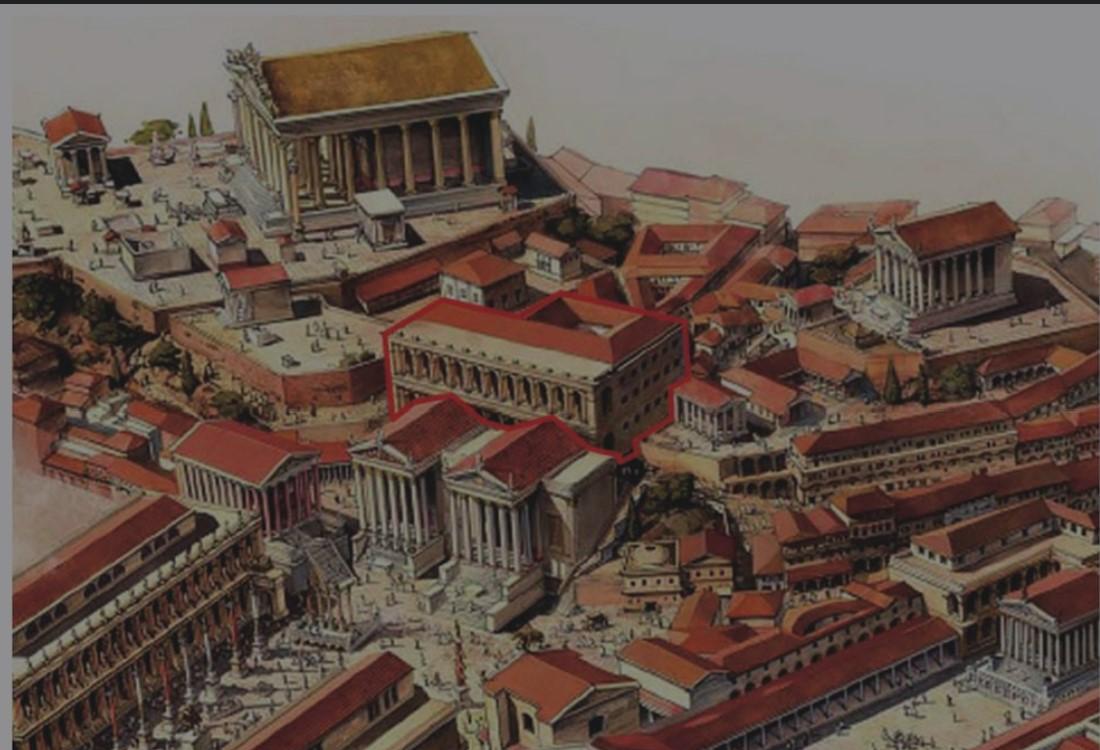Piazza del Campidoglio, also known as Piazza Municipal, is located on the Hill of Capitoline, a historical and cultural mecca in the heart of Rome.
In Ancient Roman times, several important temples were built on this slightly "concave" glyph hill, including the Temple of Jupiter, built in 509 BC, on the south summit and the Temple of Juno Moneta, built in 344 BC, and close to the Roman Forum is the Roman National Archives.

Restoration of the Capitoline Hill in Ancient Rome, red line frame for the National Archives (drawn by R. Oltean)
In the Middle Ages, the hill was destroyed like the whole city of Rome, both temples were demolished, and the Palazzo dei Conservatori was built on the site of the original Temple of Jupiter, the seat of the municipal officials of the time; on the site of the Temple of Juno the Vigilante, a church was built, Santa Maria in Aracoeli. The former National Archives was converted into a castle-like Palazzo Senatorio (now the Town Hall).
The current situation of The Capitoline Hill in Rome, with the Town Hall in the center, the Municipal Square in the background, and the remains of the Roman Forum in the front
In 1536, Michelangelo was commissioned by Pope Paul III to begin the renovation of the square. Faced with such a disorderly and irregular environment, Edmund Bacon wrote about it in Urban Design: "Let us imagine that a master of French and aesthetics like him could have demolished old buildings to allow his creativity to flourish." ”
Scene at the beginning of construction, with the Senate Palace on the front and the Conservative Palace on the right (painted around 1555)
But That's not how Michelangelo chose. His choice was to preserve the basic structure of the original building and carry out his own creations on the basis of full respect for the fruits of the labor of his predecessors.
Michelangelo noticed that the angle between the two buildings, the Palazzo della Serro and the Palazzo des Oliviers, was slightly less than 90°, and he decided to use this to design a trapezoidal square with the Senate as the central axis, like the Central Pinza Square designed by Rossellino.
He ordered the equestrian statue of the Roman Emperor Marcus Aurelius (reigned 161-180) to be moved from the Roman Forum at the foot of the hill, and placed it on the axis facing the Senate, while building a large symmetrical staircase on the façade of the Senate. He also redesigned the façade of the Palazzo conservatism on the right side of the square and designed steps leading down the hill on the central axis of the square.
Piazzale Capitoline at Michelangelo's death (by M. Merian)
Although by the time of Michelangelo's death, the entire square had not been completed, he had set an example for future generations to respect their predecessors, so that his ideas would not be "dead" as we often do today, but would still be understood and recognized by subsequent architects many years after his death. At the beginning of the 17th century, the Palazzo Nuovo was added to the left side of the square almost exactly in the form of the Conservative Palace, which finally completed the great trapezoidal square.
Before and after design of Piazza Capitoline (quoted from Edmund Bacon's Urban Design)
As Edmund Bacon said: "Michelangelo has proven with facts that humility and power can coexist in the hands of the same man, that a great project can be created without destroying the historical relics that already exist." "That's the real cleverness.
Piazza Capitoline. From a normal point of view, it is difficult to see that this is a trapezoidal square
The final piazza municipality faces the ancient Roman city center to the southeast of Mount Catpitolin and the Renaissance New Rome to the northwest of Mount Catpitolin. Its plane is trapezoidal, with a depth of 79 meters, a width of 60 meters at its widest point and 40 meters at its narrowest point. A long staircase leads from the bottom of the hill to the square, which is also trapezoidal, with small and large lower levels.
Since Rossellino's Central Piazza, the Trapezoidal Square has become a favorite of Renaissance urban designers because it looks both regular and fit to meet the requirements of decency and decency, while being slightly relaxed and not overly restrained. On the other hand, for a trapezoidal shape, when a person looks from the short side to the long side, due to the principle of perspective, it feels that the object located on the long side will be "shortened" forward, the distance "shortened", and the scale "reduced". The opposite is the opposite feeling. This trapezoidal plan of square design later became a very popular construction technique of the artist.
In the façade design of the Palazzo des Conservatos on the south side of the square, Michelangelo adopted an unusual column-style façade, with huge pilasters leading from the ground to the top of the second floor, like a giant temple, which greatly enhanced the visual impact of the building. On the other hand, the situation of the small cylinder on the side of the giant column that actually supports the two-story wall is completely different, and while having to undertake the main load task, its living space is tightly squeezed by the giant column, giving people a feeling of suffocation.
Conservative palace appearance
Michelangelo was a great man who was able to infuse his inner world not only into sculpture, painting but also architecture. His buildings exude strong personal emotions everywhere that most of his contemporaries could not match. He tried to liberate human spiritual emotions from the shackles of matter, thus opening up a new world of artistic development.